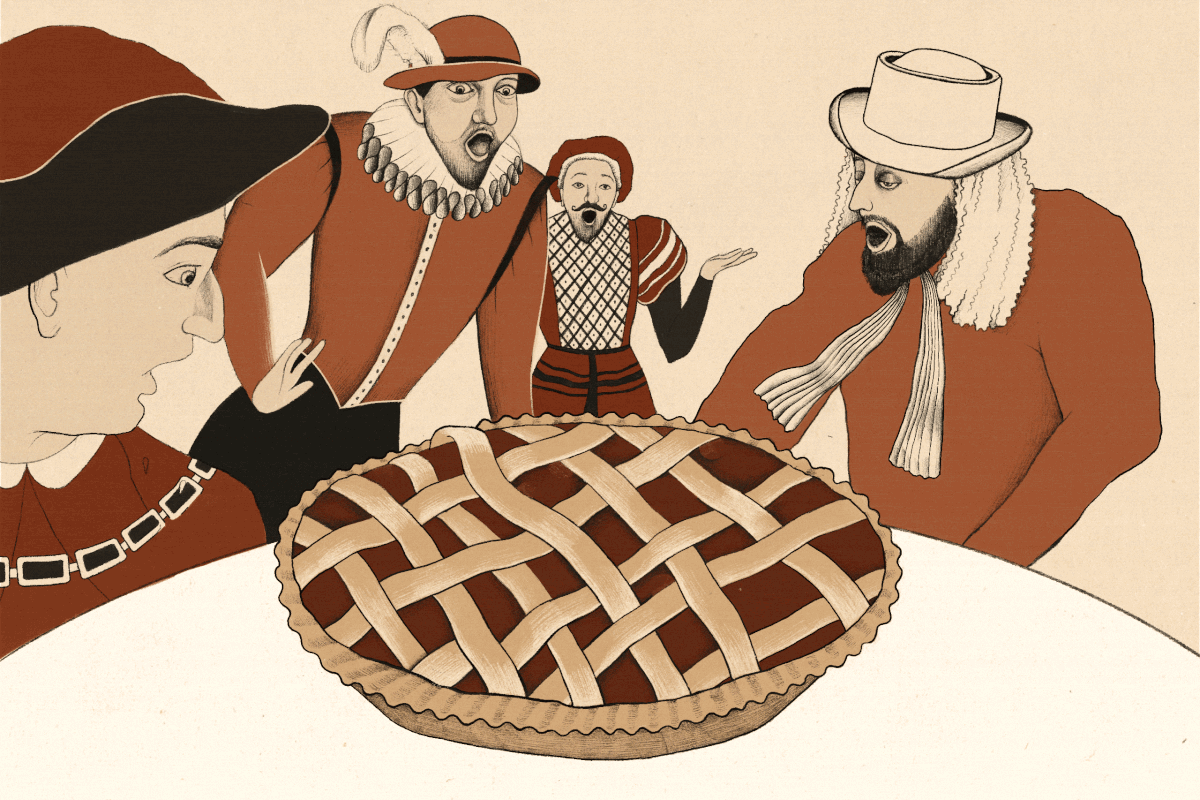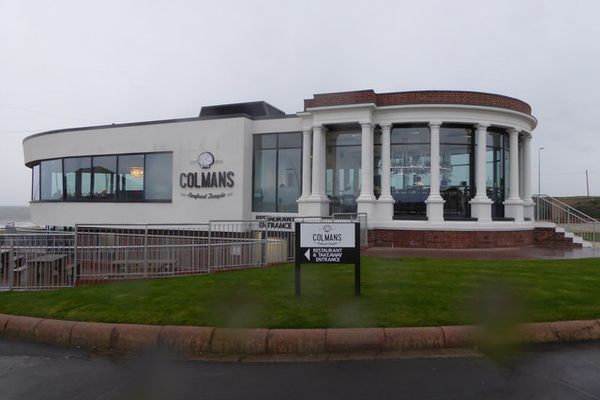

The Fantastical Feasts of England’s First Celebrity Chef
Pastry warships, frogs hopping out of pies, and other spectacles devised by Robert May.
People who love extreme dining praise it as gritty and high-octane, a way to push back against older dining traditions imagined as stuffy and overly refined. But dining in the past was more dazzling, and more dangerous, than we could ever imagine. Robert May (c. 1588–1664), a celebrity chef in Elizabethan and Jacobean England, made his name by staging elaborate feasts full of atmospheric effects, sensory experiences, and dramatic, even downright risky, stunts. At May’s banquets, clouds of gunpowder smoke choked the air. Animals hopped along the table. And diners were never really sure if the food on their plate was dead or alive.
Robert May was born in a small village in Buckinghamshire, England, where his father worked as a private chef. He spent his childhood in and around his father’s kitchen, learning how to cook the kind of food that wealthy people enjoyed: venison and game birds, sugary confections and towering jellies, fruit compotes and complex, multi-layered salads. His father’s employers were so impressed by the younger May’s burgeoning talent that they sent him abroad for further training. A teenaged May arrived in Paris without a word of French and got to work. For the next five years, he studied and read everything he could on European cooking techniques and styles. He learned French, Spanish, and Italian. He combed through manuscript recipes and printed cookbooks. He honed his skill and taste.
This training stood May in good stead when he returned to his home country at the start of the 17th century. In 1609, he celebrated his 21st birthday, and it was from this moment that he believed his career truly began. He worked in the well-stocked kitchens of earls and countesses, viscounts and viscountesses, knights, lords and ladies, where he perfected the art of fine dining. Over the next 50 years, May would work in 13 great kitchens, in London as well as Sussex, Essex, Kent, and Yorkshire. As he traveled the country, he became admired for his distinct style. For May, a meal wasn’t just sustenance, it was spectacle.

May’s cooking was shaped by a long history of fantastic feasting in England. “May was nostalgic for the more decadent dining spectacles of the past,” explains Heather Wolfe, associate librarian and curator of manuscripts at the Folger Shakespeare Library in Washington, D.C., which holds several original copies of May’s cookbook. “He wanted to offer a different, older kind of hospitality.” For May, this meant returning to medieval banqueting traditions, where dishes were paraded to the table and feasts were accompanied by singing, dancing, and even acrobatics. Platter by platter, the young chef began to design ever more elaborate dining fantasies.
Though there is very little written about May, the chef’s cookbook, The Accomplisht Cook (published c. 1660), provides a deep dive into his methods and motivations. When he served dinner to guests, for instance, May wrote that he wanted to ensure the “admiration…[of] the beholders,” and for everyone to finish their meals “with much delight and content.” For holidays and “Festival Times,” for example, May prepared elaborate set-pieces that he called “Triumphs and Trophies in Cookery.”
One dining spectacle saw May fashioning miniature castles and ships out of pastry, complete with “with flags and streamers” as well as “Battlements, Percullices [Portcullises], Gates, and Draw-Bridges made of pasteboard,” and outfitted with tiny cannons packed with real gunpowder. He and his kitchen staff would announce that the ship and castle were going to engage in a mock battle, gunpowder charges were lit, and the pastry would explode in a cloud of smoke. This would supposedly assault diners’ noses with what May called “the stink of the powder,” a special effect that he believed would delight and disgust in equal measure.
Another “Triumph and Trophy” had May staging what were, essentially, aromatic water balloon fights over the dinner table. He instructed his staff to blow the yolks and whites out of raw eggs, then to fill the clean, hollow eggshells with rose water and seal the holes. The eggs were then placed strategically around the dining table for guests to play with. When thrown, the eggs would break, sprinkling everyone with rose water and perfuming the room.
May’s dining spectacles were a success. Two fans even wrote poems about their experiences at his sensational tables, with one asking “Who can in Paste erect, of finest flour, / A compleat Fort, a Castle, or a Tower[?],” and another praising his abilities “to candy, to preserve, to souce, to pickle, / To make rare Sauces both to please, and tickle.”
But not all of May’s meals were light-hearted fare that pleased and tickled. His signature holiday dish was a life-sized “deer” made out of pastry that was made to look as if it had just been shot with arrows and had fallen onto the dining table. When diners plucked the arrows out of the deer’s side, wine would gush out, “as blood running out of a wound,” offering guests a moment of surprised horror.
Live animals also had their roles to play. Behind the scenes, May and his staff filled blind-baked pie crusts with live frogs; they’d then cover the squirming amphibians with a baked top crust, carry the dish to the table, and wait for the animals to crawl out. May used this trick with live birds, too. When diners tried to cut into their pies, the birds would erupt out of the pan, flap so hard that they would extinguish the candles on the table, and plunge diners into sudden darkness. While live animals hopping and flapping on the table caused “the Ladies to skip and shreek,” May believed this initial fear would give way to amusement: “The flying Birds and skipping Frogs, the one above, the other beneath, will cause much delight and pleasure to the whole company,” he wrote.

The fanciful chef certainly tried to cultivate an air of mystery and surprise at his tables, but he worked equally hard to cultivate his own image. Most information about the lives of chefs in Elizabethan and Jacobean England has been lost, because many—even those who had come to be respected—came from humble origins. But May did something that would ensure he was remembered well beyond his death: He promoted himself in print.
As he neared his 71st birthday, May decided to create a permanent testament to his knowledge. For all that May’s banquets were remarkable, they were also fleeting. In the 16th and 17th centuries, people didn’t write restaurant reviews; the first Michelin stars for fine dining weren’t awarded until 1926. When the smoke cleared and the guests departed, May worried that his dining spectacles would be forgotten. He became determined to write a book. “God and my own Conscience,” he recalled in the dedication to the Accomplisht Cook, “would not permit me to bury these my Experiences with my Silver Hairs in the Grave.”
In his resulting autobiography-slash-cookbook, he explained in clear, straightforward language how to make the fabulous and otherworldly food spectacles he’d invented. “May presented himself as both authoritative and approachable,” says Wolfe. In the book, “it was as if May was your chef and you were his virtual apprentice. He wanted to demystify the art of cooking and be the face of modern hospitality.”
For May, this meant quite literally putting his face in the book. He included an author portrait: a first in the period. Typically only elite and well-educated people such as royalty, politicians, and famous authors were given this honor at the time. According to Wolfe, May was the first food-worker to achieve this distinction. The Accomplisht Cook also commanded an impressive price: five shillings, double the cost of most other books, and the rough equivalent of $50 today.
These branding strategies paid off, and May’s books flew off the shelves. “It was published five times in 25 years,” says Wolfe. “It was a hit.”
May’s mass appeal can be seen in the wide variety of publications that featured advertisements for his book. Publishers placed the promotions in geography texts and religious treatises, books of poetry and chemistry; even John Selden, one of the most respected jurists and intellectuals of his day, had an ad for The Accomplisht Cook in the back of his book.
Perhaps to appeal to this diverse audience, May included some recipes that were more approachable than others. The book offered 21 different ways to make an omelet, knowledge that was probably useful only in big, wealthy households. But other recipes have more widespread, and enduring, appeal. May’s beet salad called for beets, baby spinach, sorrel, and dried currants, with a dressing of oil and vinegar. His broiled lobster was blackened on a gridiron and dressed with butter, lemon, and a sprinkle of nutmeg. A luscious almond pudding called for ground almonds, cream, eggs, sugar, and rose water.
For anyone who wants to give May’s recipes a try, the Folger Shakespeare Library has digitized the whole book, free and available to the public. Just leave the live frogs and birds off the shopping list.
Gastro Obscura covers the world’s most wondrous food and drink.
Sign up for our regular newsletter.























Follow us on Twitter to get the latest on the world's hidden wonders.
Like us on Facebook to get the latest on the world's hidden wonders.
Follow us on Twitter Like us on Facebook